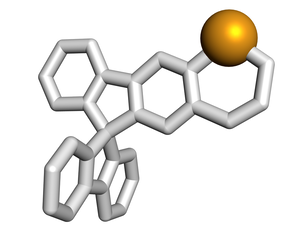Metallaaromatic Spirobifluorenes

Metallaaromatic spirobifluorenes
Metallaaromatic compounds have attracted the focus of many studies after the synthesis of the first metallabenzene1 (1) with the ambition to expand the scope of the purely organic couterparts.2 Replacements of a C–H moiety by a transition metal atom to give access to polycyclic metallaaromatic hydrocarbons are however scarce and limited to metalla-naphthalene (2 and 3), -anthracene (4), and only evidences of –phenanthrene (5) derivatives. In this regard, we have contributed with the development of a synthetic methodology that enables the formation of stable metalla-naphthalene (6 and 7) and phenanthrene (8 and 9) biaryl derivatives. Notably, the hindered rotation about the biaryl bond introduces atropisomerism when properly substituted (7 and 9) opening access to axially chiral metallaaromatic compounds (Scheme 1). On the other hand, spirobifluorenes have been extensible used in organic electronics,5 and recently, we have shown theoretically3 and experimentally4 their reliability for the construction of chiroptical systems. However, even when the electronic properties of SFBs are strongly dependent on the funtionalization6 (o sustituir por Incorporar ciclometalados SBF) and chiral organometallic compounds typically present remarkably higher chiroptical responses compared to their organic counterparts, no examples of metallaromatic SBFs are known to date . A manuscript is in preparation, with the synthesis, characterization and theoretical analysis of the first metallaaromatic spirobifluorene. These results represents a proof of principal for this new class of compounds.
Metallaaromatic compounds have attracted the focus of many studies after the synthesis of the first metallabenzene1 (1) with the ambition to expand the scope of the purely organic couterparts.2 Replacements of a C–H moiety by a transition metal atom to give access to polycyclic metallaaromatic hydrocarbons are however scarce and limited to metalla-naphthalene (2 and 3), -anthracene (4), and only evidences of –phenanthrene (5) derivatives. In this regard, we have contributed with the development of a synthetic methodology that enables the formation of stable metalla-naphthalene (6 and 7) and phenanthrene (8 and 9) biaryl derivatives. Notably, the hindered rotation about the biaryl bond introduces atropisomerism when properly substituted (7 and 9) opening access to axially chiral metallaaromatic compounds (Scheme 1). On the other hand, spirobifluorenes have been extensible used in organic electronics,5 and recently, we have shown theoretically3 and experimentally4 their reliability for the construction of chiroptical systems. However, even when the electronic properties of SFBs are strongly dependent on the funtionalization6 (o sustituir por Incorporar ciclometalados SBF) and chiral organometallic compounds typically present remarkably higher chiroptical responses compared to their organic counterparts, no examples of metallaromatic SBFs are known to date . A manuscript is in preparation, with the synthesis, characterization and theoretical analysis of the first metallaaromatic spirobifluorene. These results represents a proof of principal for this new class of compounds.
